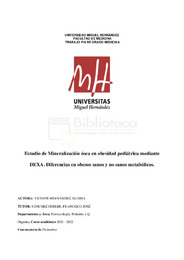Por favor, use este identificador para citar o enlazar este ítem:
https://hdl.handle.net/11000/28455Registro completo de metadatos
| Campo DC | Valor | Lengua/Idioma |
|---|---|---|
| dc.contributor.advisor | Sánchez Ferrer, Francisco José | - |
| dc.contributor.author | Vicente Hernández, Gloria | - |
| dc.contributor.other | Departamentos de la UMH::Farmacología, Pediatría y Química Orgánica | es_ES |
| dc.date.accessioned | 2022-11-23T12:44:54Z | - |
| dc.date.available | 2022-11-23T12:44:54Z | - |
| dc.date.created | 2021-12-01 | - |
| dc.identifier.uri | https://hdl.handle.net/11000/28455 | - |
| dc.description.abstract | Introducción: La obesidad es un problema de salud mundial y está ligada a numerosas patologías tanto en la edad adulta como en la propia infancia. La infancia es la etapa donde mayor pico de crecimiento de densidad ósea hay. Sabemos que con el aumento de masa grasa también hay un aumento de densidad ósea, los últimos estudios sugieren que no aumenta de forma proporcional a ésta, por lo que aumenta el riesgo de fracturas. Existe una clasificación de la población obesa en metabólicamente sanos (MHO) y metabólicamente no sanos (MUO) según su riesgo de asociar complicaciones metabólicas. El objetivo principal de este estudio es ver si existe una diferencia estadísticamente significativa en la Densidad Mineral ósea (DMO) entre los MHO y MUO. Material yMétodos: Se ha utilizado una muestra de 96 pacientes de entre 6 y 17 años que acudieron al servicio de endocrinología del Hospital Universitario de Sant Joan en Alicante. Todos ellos con un Z-score del IMC >2 DE para su sexo, edad y población de referencia. Se les clasificó según el índice Homeostais Model assessment (HOMA) en MHO y MUO y se les sometió a una Densitometría ósea, calculando su Contenido mineral óseo o CMO y su densidad mineral ósea o DMO. Resultados: Los 33 pacientes que fueron clasificados como MUO tenían mayor DMO y CMO, además de un Z-score del IMC, edad de visita y porcentaje de grasa troncular superior a las de los 63 pacientes clasificados como MHO. Además, se realizó un desglose de los componentes del índice HOMA(glucemia e insulina en sangre) y se les comparó individualmente con laDMO. Los resultados mostraron que el diagrama de dispersión de puntos que valora la DMO frente a la insulina sería igual que el diagrama que valora la DMO frente al HOMA, mientras que la glucosa no mostraría ningún patrón específico. Discusión: Los resultados muestran una DMO mayor en los MUO. Por otra parte, la asociación encontrada entre el HOMA y la DMO que parece depender principalmente de la insulina podría deberse al papel de la insulina como activador de los osteoblastos. | es_ES |
| dc.description.abstract | Introduction: Obesity is a global health problem, and it is linked to great number of pathologies both later in life. Childhood is the stage where there is the greatest peak of bone mass growth. With the increase in fat mass there is also an increase in bone mineral density, but the latest studies suggest that the Bone mineral density (BMD) does not increase proportionally to body weight, increasing consequently the risk of fractures. There is a new classification for obese population, classifying them as either metabolically healthy obese (MHO) or metabolically unhealthy obese (MUO) according to their risk of associating metabolic complications. The aim of this study is to find out if there is a statistically significant difference in BMD between the MHO and MUO. Material and methods: In this study, we used a sample of 96 patients between the age of 6 and 17, who all attended the endocrinology service of the Sant Joan university hospital in Alicante. All of them with a BMI Z-score> 2 SD for their sex, age and reference population. They were classified according to the Homeostasis Model assessment index (HOMA) into MHO and MUO and underwent a DEXA scan, with which their bone mineral content or CMO and their bone mineral density or BMD were calculated. Results: The 33 patients classified as MUO had a greater BMD and BMC, moreover, they also had a higher IMC Z-score, age, and troncular fat percentage than the 63 patients classified as MHO. In addition, an apportion of the HOMAclassification components (blood glucose and insulin) was made, and they were individually compared with the BMD. The results showed that the scattering graphic that shows the value BMD in relation to blood insulin levels would be the almost equal to the dispersion graphic showing BMD in relation to HOMA, whereas blood glucose would not show any specific statistical pattern. Discussion: The results show a higher BMD in MUO patients. On the other hand, the association we found between the role of HOMA in BMD, which seems to depend mainly on insulin, could be due to the role of insulin as an activator of osteoblasts | es_ES |
| dc.format | application/pdf | es_ES |
| dc.format.extent | 24 | es_ES |
| dc.language.iso | spa | es_ES |
| dc.publisher | Universidad Miguel Hernández | es_ES |
| dc.rights | info:eu-repo/semantics/openAccess | es_ES |
| dc.rights | Attribution-NonCommercial-NoDerivatives 4.0 Internacional | * |
| dc.rights.uri | http://creativecommons.org/licenses/by-nc-nd/4.0/ | * |
| dc.subject | Obesidad | es_ES |
| dc.subject | Niños | es_ES |
| dc.subject | Homeostasis Model Assessment | es_ES |
| dc.subject | Densitometría | es_ES |
| dc.subject.other | CDU::6 - Ciencias aplicadas::61 - Medicina | es_ES |
| dc.title | Estudio de Mineralización ósea en obesidad pediátrica mediante DEXA. Diferencias en obesos sanos y no sanos metabólicos. | es_ES |
| dc.type | info:eu-repo/semantics/bachelorThesis | es_ES |

Ver/Abrir:
Vicente Hernández, Gloria TFG .pdf
835,97 kB
Adobe PDF
Compartir:
 La licencia se describe como: Atribución-NonComercial-NoDerivada 4.0 Internacional.
La licencia se describe como: Atribución-NonComercial-NoDerivada 4.0 Internacional.
.png)